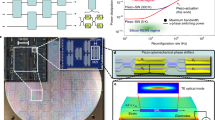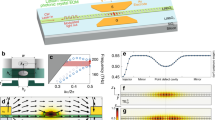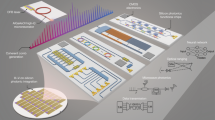Abstract
Integrated microwave photonics (MWP) is an intriguing technology for the generation, transmission and manipulation of microwave signals in chip-scale optical systems1,2. In particular, ultrafast processing of analogue signals in the optical domain with high fidelity and low latency could enable a variety of applications such as MWP filters3,4,5, microwave signal processing6,7,8,9 and image recognition10,11. An ideal integrated MWP processing platform should have both an efficient and high-speed electro-optic modulation block to faithfully perform microwave–optic conversion at low power and also a low-loss functional photonic network to implement various signal-processing tasks. Moreover, large-scale, low-cost manufacturability is required to monolithically integrate the two building blocks on the same chip. Here we demonstrate such an integrated MWP processing engine based on a 4 inch wafer-scale thin-film lithium niobate platform. It can perform multipurpose tasks with processing bandwidths of up to 67 GHz at complementary metal–oxide–semiconductor (CMOS)-compatible voltages. We achieve ultrafast analogue computation, namely temporal integration and differentiation, at sampling rates of up to 256 giga samples per second, and deploy these functions to showcase three proof-of-concept applications: solving ordinary differential equations, generating ultra-wideband signals and detecting edges in images. We further leverage the image edge detector to realize a photonic-assisted image segmentation model that can effectively outline the boundaries of melanoma lesion in medical diagnostic images. Our ultrafast lithium niobate MWP engine could provide compact, low-latency and cost-effective solutions for future wireless communications, high-resolution radar and photonic artificial intelligence.
This is a preview of subscription content, access via your institution
Access options
Access Nature and 54 other Nature Portfolio journals
Get Nature+, our best-value online-access subscription
$29.99 / 30 days
cancel any time
Subscribe to this journal
Receive 51 print issues and online access
$199.00 per year
only $3.90 per issue
Buy this article
- Purchase on Springer Link
- Instant access to full article PDF
Prices may be subject to local taxes which are calculated during checkout




Similar content being viewed by others
Data availability
The data used to produce the plots within this paper are available from Zenodo at https://doi.org/10.5281/zenodo.10464317 (ref. 66).
Code availability
The code used to produce the plots within this paper is available from Zenodo at https://doi.org/10.5281/zenodo.10463902 (ref. 67).
References
Capmany, J. & Novak, D. Microwave photonics combines two worlds. Nat. Photon. 1, 319–330 (2007).
Marpaung, D., Yao, J. & Capmany, J. Integrated microwave photonics. Nat. Photon. 13, 80–90 (2019).
Shu, H. et al. Microcomb-driven silicon photonic systems. Nature 605, 457–463 (2022).
Fandiño, J. S., Muñoz, P., Doménech, D. & Capmany, J. A monolithic integrated photonic microwave filter. Nat. Photon. 11, 124–129 (2017).
Sancho, J. et al. Integrable microwave filter based on a photonic crystal delay line. Nat. Commun. 3, 1075 (2012).
Liu, W. et al. A fully reconfigurable photonic integrated signal processor. Nat. Photon. 10, 190–195 (2016).
Pérez, D. et al. Multipurpose silicon photonics signal processor core. Nat. Commun. 8, 636 (2017).
Zhang, W. & Yao, J. Photonic integrated field-programmable disk array signal processor. Nat. Commun. 11, 406 (2020).
Zhang, W. & Yao, J. A fully reconfigurable waveguide Bragg grating for programmable photonic signal processing. Nat. Commun. 9, 1396 (2018).
Feldmann, J. et al. Parallel convolutional processing using an integrated photonic tensor core. Nature 589, 52–58 (2021).
Xu, X. et al. 11 TOPS photonic convolutional accelerator for optical neural networks. Nature 589, 44–51 (2021).
Ilderem, V. The technology underpinning 5G. Nat. Electron. 3, 5–6 (2020).
Khan, M. H. et al. Ultrabroad-bandwidth arbitrary radiofrequency waveform generation with a silicon photonic chip-based spectral shaper. Nat. Photon. 4, 117–122 (2010).
Wang, J. et al. Reconfigurable radio-frequency arbitrary waveforms synthesized in a silicon photonic chip. Nat. Commun. 6, 5957 (2015).
Zhu, C. et al. Silicon integrated microwave photonic beamformer. Optica 7, 1162–1170 (2020).
Tao, Y. et al. Fully on-chip microwave photonic instantaneous frequency measurement system. Laser Photonics Rev., 16, 2200158 (2022).
Rahim, A. et al. Taking silicon photonics modulators to a higher performance level: state-of-the-art and a review of new technologies. Adv. Photonics 3, 024003 (2021).
Roeloffzen, C. G. et al. Silicon nitride microwave photonic circuits. Opt. Express 21, 22937–22961 (2013).
Zhuang, L., Roeloffzen, C. G., Hoekman, M., Boller, K.-J. & Lowery, A. J. Programmable photonic signal processor chip for radiofrequency applications. Optica 2, 854–859 (2015).
Dong, J. et al. Compact, flexible and versatile photonic differentiator using silicon Mach–Zehnder interferometers. Opt. Express 21, 7014–7024 (2013).
Liu, W., Zhang, W. & Yao, J. Silicon-based integrated tunable fractional order photonic temporal differentiators. J. Lightwave Technol. 35, 2487–2493 (2017).
Slavík, R. et al. Photonic temporal integrator for all-optical computing. Opt. Express 16, 18202–18214 (2008).
Xu, X. et al. Microcomb-based photonic RF signal processing. IEEE Photonic Technol. Lett. 31, 1854–1857 (2019).
Minasian, R. A., Chan, E. & Yi, X. Microwave photonic signal processing. Opt. Express 21, 22918–22936 (2013).
Park, Y., Azaña, J. & Slavík, R. Ultrafast all-optical first-and higher-order differentiators based on interferometers. Opt. Lett. 32, 710–712 (2007).
Zheng, A. et al. Tunable fractional-order differentiator using an electrically tuned silicon-on-isolator Mach–Zehnder interferometer. Opt. Express 22, 18232–18237 (2014).
Ferrera, M. et al. On-chip CMOS-compatible all-optical integrator. Nat. Commun. 1, 29 (2010).
Li, M., Jeong, H.-S., Azaña, J. & Ahn, T.-J. 25-terahertz-bandwidth all-optical temporal differentiator. Opt. Express 20, 28273–28280 (2012).
Morton, P. A. et al. High-power, high-linearity, heterogeneously integrated III–V on Si MZI modulators for RF photonics systems. IEEE Photonics J. 11, 1–10 (2019).
Tran, M. A. et al. Extending the spectrum of fully integrated photonics to submicrometre wavelengths. Nature 610, 54–60 (2022).
Xiang, C. et al. Laser soliton microcombs heterogeneously integrated on silicon. Science 373, 99–103 (2021).
Boes, A. et al. Lithium niobate photonics: unlocking the electromagnetic spectrum. Science 379, 4396 (2023).
Zhang, M., Wang, C., Kharel, P., Zhu, D. & Lončar, M. Integrated lithium niobate electro-optic modulators: when performance meets scalability. Optica 8, 652–667 (2021).
Zhang, Y. et al. Systematic investigation of millimeter-wave optic modulation performance in thin-film lithium niobate. Photonics Res. 10, 2380–2387 (2022).
Mercante, A. J. et al. Thin film lithium niobate electro-optic modulator with terahertz operating bandwidth. Opt. Express 26, 14810–14816 (2018).
He, M. et al. High-performance hybrid silicon and lithium niobate Mach–Zehnder modulators for 100 Gbit s−1 and beyond. Nat. Photon. 13, 359–364 (2019).
Wang, C. et al. Integrated lithium niobate electro-optic modulators operating at CMOS-compatible voltages. Nature 562, 101–104 (2018).
Ahmed, A. N. R. et al. Subvolt electro-optical modulator on thin-film lithium niobate and silicon nitride hybrid platform. Opt. Lett. 45, 1112–1115 (2020).
Feng, H. et al. Ultra-high-linearity integrated lithium niobate electro-optic modulators. Photonics Res. 10, 2366–2373 (2022).
Zhang, M., Wang, C., Cheng, R., Shams-Ansari, A. & Lončar, M. Monolithic ultra-high-Q lithium niobate microring resonator. Optica 4, 1536–1537 (2017).
Escalé, M. R., Pohl, D., Sergeyev, A. & Grange, R. Extreme electro-optic tuning of Bragg mirrors integrated in lithium niobate nanowaveguides. Opt. Lett. 43, 1515–1518 (2018).
Hu, Y. et al. On-chip electro-optic frequency shifters and beam splitters. Nature 599, 587–593 (2021).
Zhou, J. et al. Electro-optically switchable optical true delay lines of meter-scale lengths fabricated on lithium niobate on insulator using photolithography assisted chemo-mechanical etching. Chin. Phys. Lett. 37, 084201 (2020).
Luke, K. et al. Wafer-scale low-loss lithium niobate photonic integrated circuits. Opt. Express 28, 24452–24458 (2020).
Li, Z. et al. High density lithium niobate photonic integrated circuits. Nat. Commun. 14, 4856 (2023).
Zhang, M., Yu, F., Zhao, J., Zhang, L. & Li, Q. BEFD: boundary enhancement and feature denoising for vessel segmentation. In Proc. International Conference on Medical Image Computing and Computer-Assisted Intervention (eds Martel, A. L. et al.) 775–785 (Springer, 2020).
Kharel, P., Reimer, C., Luke, K., He, L. & Zhang, M. Breaking voltage–bandwidth limits in integrated lithium niobate modulators using micro-structured electrodes. Optica 8, 357–363 (2021).
Hill, M. T. et al. A fast low-power optical memory based on coupled micro-ring lasers. Nature 432, 206–209 (2004).
Tan, S. et al. High-order all-optical differential equation solver based on microring resonators. Opt. Lett. 38, 3735–3738 (2013).
Pan, S. & Yao, J. UWB-over-fiber communications: modulation and transmission. J. Lightwave Technol. 28, 2445–2455 (2010).
Perez, D. et al. Silicon photonics rectangular universal interferometer. Laser Photonics Rev. 11, 1700219 (2017).
Wen, H. et al. Few-mode fibre-optic microwave photonic links. Light: Sci. Appl. 6, 17021 (2017).
Zhang, M. et al. Broadband electro-optic frequency comb generation in a lithium niobate microring resonator. Nature 568, 373–377 (2019).
Ye, K. et al. Surface acoustic wave stimulated Brillouin scattering in thin-film lithium niobate waveguides. Preprint at https://doi.org/10.48550/arXiv.2311.14697 (2023).
Rodrigues, C. C. et al. On-chip backward stimulated Brillouin scattering in lithium niobate waveguides. Preprint at https://doi.org/10.48550/arXiv.2311.18135 (2023).
He, K., Zhang, X., Ren, S. & Sun, J. Deep residual learning for image recognition. In Proc. IEEE Conference on Computer Vision and Pattern Recognition (eds Bajcsy, R. et al.) 770–778 (IEEE, 2016).
Chen, L., Zhu, Y., Papandreou, G., Schroff, F. & Adam, H. Encoder-decoder with atrous separable convolution for semantic image segmentation. In Proc. European Conference on Computer Vision (eds Ferrari, V. et al.) 801–818 (Springer, 2018).
Milletari, F., Navab, N. & Ahmadi, S. A. V-net: fully convolutional neural networks for volumetric medical image segmentation. In Proc. International Conference on 3D Vision 565–571 (IEEE, 2016).
Codella, N. C. et al. Skin lesion analysis toward melanoma detection. In Proc. International Symposium on Biomedical Imaging 168–172 (IEEE, 2018).
Wang, B., de Lima, T. F., Shastri, B. J., Prucnal, P. R. & Huang, C. Multi-wavelength photonic neuromorphic computing for intra and interchannel distortion compensations in WDM optical communication systems. IEEE J. Sel. Top. Quantum Electron. 29, 7400212 (2022).
Huang, C. et al. A silicon photonic–electronic neural network for fibre nonlinearity compensation. Nat. Electron. 4, 837–844 (2021).
Huang, C. et al. High-capacity space-division multiplexing communications with silicon photonic blind source separation. J. Lightwave Technol. 40, 1617–1632 (2022).
Gao, J., Han, X., Lei, X. & Yu, Y. TEC power consumption in laser array packaging. Opt. Quantum Electron. 49, 1–13 (2017).
Desurvire, E. & Zervas, M. N. Erbium-doped fiber amplifiers: principles and applications. Phys. Today 48, 56–58 (1995).
Siew, S. Y. et al. Review of silicon photonics technology and platform development. J. Lightwave Technol. 39, 4374–4389 (2021).
Feng, H. et al. Integrated lithium niobate microwave photonic processing engine. Zenodo https://doi.org/10.5281/zenodo.10464317 (2024).
Feng, H. et al. Integrated lithium niobate microwave photonic processing engine. Zenodo https://doi.org/10.5281/zenodo.10463902 (2024).
Acknowledgements
We thank H. K. Tsang for the use of the high-speed measurement equipment. We thank C. F. Yeung, S. Y. Lao, C. W. Lai and L. Ho at the Nanosystem Fabrication Facility at the Hong Kong University of Science and Technology for technical support with the stepper lithography and plasma-enhanced chemical vapour deposition process. We thank W. H. Wong and K. Shum at CityU for their help in device fabrication and measurement. This work is supported by the National Natural Science Foundation of China (grant no. 61922092), the Research Grants Council, University Grants Committee (grant nos. CityU 11204820, CityU 21208219, N_CityU113/20 and C1002-22Y), the Croucher Foundation (grant no. 9509005), the Innovation and Technology Fund (grant no. ITS/226/21FP) and the City University of Hong Kong (grant nos. 9610402 and 9610455).
Author information
Authors and Affiliations
Contributions
H.F. and C.W. conceived the idea. H.F. designed and fabricated the wafer with the help of Z.C., Y.Z., K.Z. and W.S. T.G. and X.G. performed the numerical simulations. H.F., T.G. and B.W. carried out the high-speed measurements and analysed the data with the help of X.G., S.Z. and Y.Z. H.F. prepared the manuscript with contributions from all authors. C.H., Y.Y. and C.W. supervised the project. H.F. and T.G. contributed equally to this work.
Corresponding author
Ethics declarations
Competing interests
The authors declare no competing interests.
Peer review
Peer review information
Nature thanks Jose Azana, Andreas Boes and David Marpaung for their contribution to the peer review of this work. Peer reviewer reports are available.
Additional information
Publisher’s note Springer Nature remains neutral with regard to jurisdictional claims in published maps and institutional affiliations.
Extended data figures and tables
Extended Data Fig. 1 Analog signal processing bandwidth analysis based on sawtooth signal.
a Time- and frequency- domain representations of sawtooth signal. b Analog bandwidth limitations of various components in our experiment. c Measured temporal differentiation results (solid) of sawtooth signals at fundamental frequencies of 20, 22, and 24 GHz, in comparison with simulated data (dashed) taking into consideration the first three harmonics. d Measured optical spectra of the differentiated signals, in comparison with the simulated results (red). e Measured (blue dots) optical power of the third-harmonic component of differentiated sawtooth signals at frequencies from 57 to 72 GHz, together with inferred on-chip performances after de-embedding equipment responses (red circles) and simulation results (red curve). Osc., oscilloscope. Lim., limitation. Sim., simulation.
Extended Data Fig. 2 Error analysis under various practical limitations.
a–d, Simulated output signals (red) are shown in comparison with the ideal response (blue) when considering the limitation of equipment bandwidth (a), drifting of device operation point (b), as well as the processing bandwidth limitations of the MZI-based differentiator (c) and the ring-based integrator (d). F.R., frequency response of the devices.
Extended Data Fig. 4 Edge-detection results of a representative melanoma lesion image.
a. Raw image. b–d. Edge-extracted images using convolution (b) and simple differentiation (c) algorithms in electronic computers, and our photonic-assisted edge detector (d). e. Ground truth.
Supplementary information
Rights and permissions
Springer Nature or its licensor (e.g. a society or other partner) holds exclusive rights to this article under a publishing agreement with the author(s) or other rightsholder(s); author self-archiving of the accepted manuscript version of this article is solely governed by the terms of such publishing agreement and applicable law.
About this article
Cite this article
Feng, H., Ge, T., Guo, X. et al. Integrated lithium niobate microwave photonic processing engine. Nature 627, 80–87 (2024). https://doi.org/10.1038/s41586-024-07078-9
Received:
Accepted:
Published:
Issue Date:
DOI: https://doi.org/10.1038/s41586-024-07078-9
Comments
By submitting a comment you agree to abide by our Terms and Community Guidelines. If you find something abusive or that does not comply with our terms or guidelines please flag it as inappropriate.



